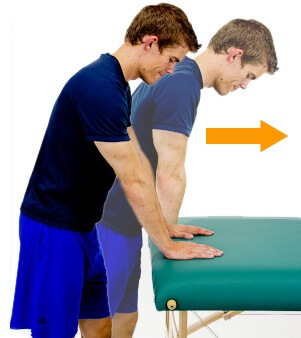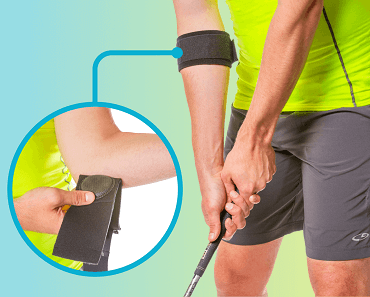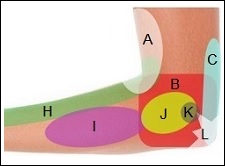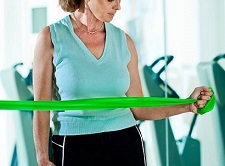- Home
- Elbow Pain Diagnosis
- Forearm Tendonitis
- Golfers Elbow
Golfers Elbow
Written By: Chloe Wilson BSc (Hons) Physiotherapy
Reviewed By: SPE Medical Review Board
Golfers elbow is the most common cause of pain on the inner side of the elbow.
Also known as medial epicondylitis, it is caused by damage to the tendons that bend and twist the forearm and hand.
Golfers elbow symptoms typically develop gradually from overuse, although it can occur more rapidly after an elbow injury.
Despite the name, it doesn’t just affect golf players. Medial epicondylitis is common in manual workers, athletes who play racket sports and weightlifters.
What Is Golfers Elbow?
Golfers elbow is a type of forearm tendonitis that occurs on the inner side of the elbow at the medial epicondyle, a bony lump that protrudes from the lower end of the humerus (upper arm bone).
A number of the forearm muscles join together at the elbow to form the common flexor tendon:
- Flexor Digitorum Superficialis
- Flexor Carpi Ulnaris
- Flexor Carpi Radialis
- Pronator Teres
- Palmaris Longus
Tendons are thick, cord like structures that connect muscles to bone.
The common flexor tendon is approximately 3cm long and attaches these muscles to the medial epicondyle. Damage to the common flexor tendon from overloading, overstretching or occasionally a one-off injury leads to inflammation of the tendon which results in golfers elbow.
There are lots of other names for golfers elbow including baseball elbow, suitcase elbow, forehand tennis elbow, pitchers elbow, throwers elbow, climbers elbow and medial elbow tendonitis, but they all refer to the same thing.
Golfers elbow is the most common cause of inner elbow pain and can also cause pain in the forearm. A similar condition occurs on the outer elbow where overuse causes irritation and damage at the common extensor tendon, known as Lateral Epicondylitis aka golfers elbow.
Causes Of Medial Epicondylitis
Golfers elbow is usually caused by repetitive overuse of the forearm muscles which places strain through the common flexor tendon. The forearm muscles let you grip things, rotate your arm and bend your wrist and fingers.
Repetitive overuse of these muscles can lead to overloading and microtearing of the tendon fibres. This damage leads to inflammation of the common flexor tendon and over time may result in degeneration and wear and tear with calcification, scar formation and thickening in the tendon and decreased collagen strength.
Common causes of medial epicondylitis are:
- Manual Labor: e.g. carpenters, plumbers, construction workers and DIY enthusiasts due to the forceful, repetitive actions required in labour intensive occupations, particularly where grip strength is important
- Racket Sports: due to the repetitive gripping and wrist action required. Tendonitis particularly affects those with a powerful serve or forehand or those who use a lot of top spin. Improper technique, especially with backhand, or using a racket that is too small or too heavy increases the risk of medial epicondylitis
- Throwing Sports: repetitive use especially with a poor technique e.g. low elbow position with throwing activities such as pitching or javelin hence the term “pitchers elbow”
- Heavy Lifting: with improper technique when done repetitively e.g. weightlifting can result in golfers elbow
- Golf: Repeatedly swinging a golf club, particularly if you’re technique isn’t quite right outs a lot of strain through the common flexor tendon causing golfers elbow
- Muscle Imbalance: lack of muscle strength, endurance and flexibility in the shoulder, elbow and wrist muscles increases your risk of developing golfers elbow
- Other Factors: smoking, high BMI and types 2 diabetes
Golfers elbow is typically caused by repetitive use rather than one-off overloading and usually only develops when aggravating activities are carried out for at least an hour a day on a number of consecutive days.
Medial epicondylitis can affect people at any age but is most common between the ages of 45-65. It is more common in women than men and in approximately 75% of cases affects the dominant arm.
Golfers Elbow Symptoms
Common symptoms of golfers elbow are:
- Localised Pain & Tenderness: on the inner side of the elbow at the medial epicondyle – the area is often tender to touch
- Radiating Pain: golfers elbow pain may extend down the forearm to the wrist
- Worse With Activity: The pain typically gets worse with activity and eases with rest
- Weakness: in your hands and wrists which may impact functional activities requiring gripping and twisting movements e.g. opening jars, turning door handles, picking things up and carrying bags
- Swelling: you may notice some swelling or even a lump on your elbow if there is sufficient inflammation in the tendon
The symptoms of golfers elbow tend to develop gradually over time and get progressively worse without treatment.
Golfer's elbow is often misdiagnosed as cubital tunnel syndrome which also causes inner elbow pain but is associated with tingling and numbness in the ring and little fingers.
Diagnosing Medial Epicondylitis
Your doctor or physical therapist can usually diagnose golfers elbow. They will take a full history asking lots of questions about your symptoms, how and when they started, what aggravates and eases your symptoms and your hobbies and daily activities.
They will then carry out a physical examination looking at your neck and upper limb movements and muscle strength. They will also carry out some simple diagnostic tests for medial epicondylitis.
Common diagnostic tests for golfers elbow are:
- Palpation: they will place pressure over the medial epicondyle. Pain or tenderness indicates a positive test
- Resisted Flexion: you will be asked to rest your elbow on the table and then bend your wrist down while the examiner resists the movement. Pain over the medial epicondyle indicates a positive test for golfers elbow
- Passive Testing: while the examiner palpates the medial epicondyle, they supinate your forearm (turn it palm up) and extend the wrist and elbow. Pain at the medial epicondyle indicates a positive test for golfers elbow
- Grip Strength: they may also assess your grip strength to identify any weakness or pain
These tests are usually sufficient for accurately diagnosing golfers elbow but in some cases your doctor may send you for further tests/scans e.g. ultrasound or MRI, to rule out other pathologies. If golfers elbow doesn't sound like your problem, visit the elbow pain diagnosis or forearm pain diagnosis sections for help working out what is wrong.
Golfers Elbow Treatment
Most cases of medial epicondylitis will respond well to conservative treatment that focuses on reducing pain and inflammation.
#CommissionsEarned from Amazon on qualifying purchases
Golfers elbow treatment usually involves:
1. Rest
As golfers elbow is an overuse injury, it is really important to rest from aggravating activities as much as possible to allow the tendon time to heal. Failure to do so will keep aggravating the condition and slow the healing process – think of it like picking at a scab.
However, complete rest may not always be possible e.g. if the tendonitis is linked to employment, in which case activity modification will be crucial.
2. Ice
Regularly applying an ice pack to the inner elbow for 10-15 minutes every few hours can help to reduce the pain and inflammation associated with medial epicondylitis.
Ice should be wrapped up in dish cloth or towel, or use a specially designed ice bag, rather than placing ice directly on the skin.
3. Medication
Over-the-counter painkillers and anti-inflammatories such as paracetamol and ibuprofen can help to reduce golfers elbow pain and inflammation. Talk to your pharmacist or doctor for advice.
4. Golfers Elbow Exercises
Exercises are an important part in golfers elbow rehab. It is important to get the right balance between resting to allow the tendon to heal, but maintaining and increase arm mobility and strength.

Strengthening Exercises: Strengthening the shoulder, elbow and wrist muscles can help reduce the strain through the common flexor tendon. You will normally start with isometric exercises (where you load the muscle without it changing length) and then progress on to eccentric exercises (where you load the muscle as it lengthens).
Golfers Elbow Stretches: It can really help to stretch out the muscles that attach through the common flexor tendon to reduce the strain through it.
You can find a whole selection of strengthening and stretching exercises in the Golfers Elbow Exercises section.
5. Change Tools
If your golfers elbow is linked to your job or a specific sport, it can help to change work tools or sports rackets. For example, using a larger grip size or lighter-weight item can help to reduce the strain through the common flexor tendon.
6. Injections
Corticosteroid injections can be used as part of golfers elbow treatment. A combination of corticosteroid and local anesthetic is injected into the common flexor tendon to reduce pain and inflammation.
Symptoms will usually improve around 5-7 days after the injection but some people do notice an increase in symptoms for the first 1-2 days. Steroid injections can temporarily weaken the tendon so it is important to take it easy and avoid any heavy lifting for a few days.
The benefits of corticosteroid injections for golfers elbow are usually temporary so they should not be given in isolation but combined with other treatments.
7. Golfers Elbow Brace

Wearing a counterforce brace or strap on the forearm, just below the elbow, helps to direct strain away from the common flexor tendon.
A counterforce golfers elbow brace applies pressure over the forearm flexors. This biomechanically reduces the forces pulling through the attachment site of the common extensor tendon at the medial epicondyle. This helps to reduce pain and protect against further damage.
8. Electrotherapy
Your physical therapist may recommend a course of ultrasound, laser treatment or shockwave therapy to help reduce pain and inflammation, although these are becoming less popular treatment options for tendon injuries.
9. Acupuncture
Acupuncture can be used to help reduce pain and inflammation with medial epicondylitis. The evidence to support the use of acupuncture in tendonitis is somewhat lacking at present but some people do find it beneficial in the short term.
10. Graded Return To Activities
Once the medial tendonitis pain has settled down, you can start returning to your normal activities, but you will probably need to reduce the volume, intensity, frequency and duration initially to reduce the risk of golfers elbow symptoms returning. Be guided by pain – if you notice your symptoms returning, ease off.
The sooner treatment for golfers elbow begins, the quicker it is likely to settle down. The more chronic medial epicondylitis becomes, the greater the degree of inflammation and scarring, which will result in slower healing and increase the risk of future episodes.
Golfers Elbow Surgery
If after 6-12 months of these conservative treatments there is no improvement in your golfers elbow symptoms, which is rare (less than 3% of case), then surgery may be advised.
There a various different procedures but they generally involve releasing the common flexor tendon at its attachment to the medial epicondyle and debriding (removing) any scar tissue. Golfers elbow surgery has a 60-70% success rate.
Summary
- Golfers elbow is a type of forearm tendonitis that causes inner elbow pain and sometimes forearm pain that may radiate down to the wrist
- It is an overuse injury caused by repetitive strain on the common flexor tendon at the medial epicondyle from repetitive gripping, twisting and bending the forearm and wrist e.g. tennis, golf, baseball and DIY
- Golfers elbow more commonly affects people involved in manual trade work than sports
- Treatment involves resting from aggravating activities, ice, exercises, forearm straps and physical therapy
- Most cases of golfers elbow will respond to home treatments and recovery time will depend on the ability to avoid aggravating activities and how chronic the condition is – the sooner treatment begins, the shorter the recovery time
- A similar condition occurs in the common extensor tendon causing lateral elbow pain, know as lateral epicondylitis or Tennis Elbow
- There are lots of other possible causes of inner elbow pain including cubital tunnel syndrome which is associated with tingling and numbness in the hand
- Occasionally, golfers elbow symptoms may persist in spite of treatment in which case surgery may be recommended.
Page Last Updated: 03/12/2024
Next Review Due: 03/12/2026
Related Articles
Medical & Scientific References
- National Institute of Health: Golfers Elbow. National Library Of Medicine.
- NHS UK: Golfers Elbow


